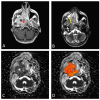Pediatric Versus Adult Nasopharyngeal Cancer in Diffusion-Weighted Magnetic Resonance Imaging
- PMID: 40647533
- PMCID: PMC12248756
- DOI: 10.3390/cancers17132237
Pediatric Versus Adult Nasopharyngeal Cancer in Diffusion-Weighted Magnetic Resonance Imaging
Abstract
Background: This study aimed at evaluating apparent diffusion coefficient (ADC) values of nasopharyngeal carcinoma (NPC) in the pre-treatment stages of NPC for establishing comparative quantitative parameters between children and adolescents compared to adults. Methods: A retrospective multicentric imaging study was conducted in three medical centers by collecting patient data over a 5-year timeframe. Patients were included in the study based on the following criteria: histopathologically proven carcinoma of the nasopharynx with all available medical records. The total sample included 20 patients (6 pediatric patients and 14 adults). A quantitative analysis of the ADC maps was performed. Two radiologists manually drew the region of interest (ROI) on ADC maps using the whole tumor on all magnetic resonance imaging (MRI) slices. The mean ADC was extracted for each patient and each radiologist's evaluation. Differences in ADC values between pediatric and adult patients were evaluated using an independent samples t-test, with normality and variance assumptions tested via the Shapiro-Wilk and Levene's tests, respectively. p-values less than 0.05 were considered statistically significant. Results: The mean ADC values extracted from the initial pre-treatment diffusion-weighted imaging (DWI) data from magnetic resonance imaging (MRI) in children were 712.22 × 10-6 mm2/s, compared to adults in whom the mean ADC values were 877.34 × 10-6 mm2/s. We found a statistically significant difference between the mean ADC values of pediatric patients and adult patients, t (17.44) = -3.15, p = 0.006, with the mean ADC values of pediatric patients (M = 712.22, standard deviation [SD] = 57.03) being lower, on average, than the mean ADC values of adult patients (M = 877.34, SD = 175.25). Conclusions: Our results showed significantly lower ADC values in pediatric patients than in adults, independent of tumor T-stage. Additionally, early-stage tumors, particularly in children, tended to exhibit even lower ADC values, suggesting potential biological distinctions across age groups.
Keywords: adults; diffusion-weighted imaging; magnetic resonance imaging; nasopharyngeal carcinoma; pediatric.
Conflict of interest statement
The authors declare no conflicts of interest.
Figures





Similar articles
-
Diagnostic Utility of Diffusion-Weighted MRI and Apparent Diffusion Coefficient Values in Differentiating Metastatic From Non-metastatic Lymph Nodes in Cervical Carcinoma.Cureus. 2025 Jun 4;17(6):e85371. doi: 10.7759/cureus.85371. eCollection 2025 Jun. Cureus. 2025. PMID: 40621327 Free PMC article.
-
Diffusion weighted imaging for improving the diagnostic performance of screening breast MRI: impact of apparent diffusion coefficient quantitation methods and cutoffs.Front Oncol. 2024 Dec 20;14:1437506. doi: 10.3389/fonc.2024.1437506. eCollection 2024. Front Oncol. 2024. PMID: 39759131 Free PMC article.
-
Supratentorial glioma grading in children by using apparent diffusion coefficient map: application of histogram analysis based on segmentation.Clin Ter. 2025 May_Jun;176(3):301-309. doi: 10.7417/CT.2025.5226. Clin Ter. 2025. PMID: 40525361
-
Sertindole for schizophrenia.Cochrane Database Syst Rev. 2005 Jul 20;2005(3):CD001715. doi: 10.1002/14651858.CD001715.pub2. Cochrane Database Syst Rev. 2005. PMID: 16034864 Free PMC article.
-
The effect of sample site and collection procedure on identification of SARS-CoV-2 infection.Cochrane Database Syst Rev. 2024 Dec 16;12(12):CD014780. doi: 10.1002/14651858.CD014780. Cochrane Database Syst Rev. 2024. PMID: 39679851 Free PMC article.
References
-
- Grønhøj C., Hjalgrim L., Jakobsen K.K., Charabi B., Mirian C., Laier G.H., Kiss K., Rechnitzer C., Friborg J., Von Buchwald C., et al. Incidence of Head and Neck Cancer in Children: A Danish Nationwide Study from 1978 to 2014. Pediatr. Blood Cancer. 2018;65:e27037. doi: 10.1002/pbc.27037. - DOI - PubMed
LinkOut - more resources
Full Text Sources

